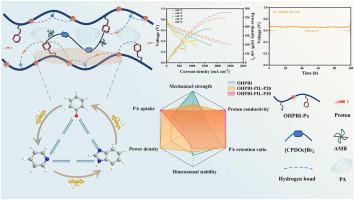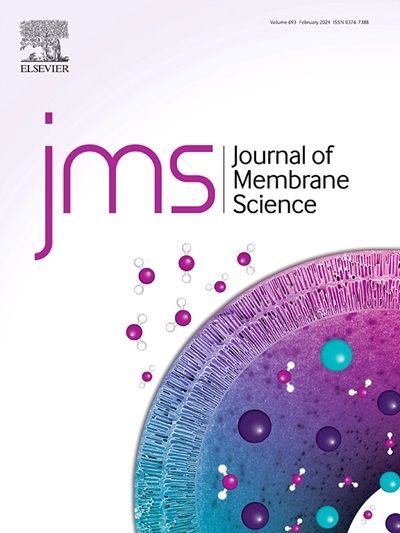High hydrogen-bond density polymeric ionic liquid composited high temperature proton exchange membrane with exceptional long-term fuel cell performance
IF 8.4
1区 工程技术
Q1 ENGINEERING, CHEMICAL
引用次数: 0
Abstract
Achieving the right balance between electrical conductivity and long-term reliability in high-temperature proton exchange membrane (HT-PEM) technologies contributes to sustainable energy recycling. This study involves a groundbreaking effort to create amphiphilic polybenzimidazoles by incorporating 2-isocyanatopyridine into hydroxy-polybenzimidazole (OHPBI). A high hydrogen-bond density network is constructed through two-by-two interactions between the hydroxyl group, the imidazole molecule and quaternary ammonium group. Quaternary ammonium polymeric ionic liquid is introduced to maintain high phosphoric acid (PA) doping and PA retention. The PA retention of the amphiphilic polybenzimidazole membrane is 87.5 % after 240 h at 160 °C/0 % RH. Furthermore, the peak power density of the amphiphilic polybenzimidazole membrane reach 837.8 mW cm−2 at 180 °C and the voltage decay rate is 0.23 mV h−1 after long-term operation. More specifically, the amphiphilic polybenzimidazole membranes show a conductivity of 138.9 mS cm−1 at 180 °C. This indicates that the amphiphilic polybenzimidazole membrane has both high power output and long-term stability. This work introduces an innovative method to improve the efficiency of PBI-based HT-PEM.

高氢键密度聚合物离子液体复合高温质子交换膜具有优异的长期燃料电池性能
在高温质子交换膜(HT-PEM)技术中实现导电性和长期可靠性之间的正确平衡有助于可持续的能源回收。本研究通过将2-异氰酸atopyridine与羟基-聚苯并咪唑(OHPBI)结合,创造了两亲性聚苯并咪唑。通过羟基、咪唑分子和季铵基团之间的二对二相互作用,构建了一个高氢键密度的网络。引入季铵盐聚合物离子液体以保持磷酸的高掺杂和保留。在160℃/ 0% RH条件下,两亲性多苯并咪唑膜在240 h后的PA保留率为87.5%。在180℃下,两亲性多苯并咪唑膜的峰值功率密度达到837.8 mW cm−2,长期工作后的电压衰减率为0.23 mV h−1。更具体地说,两亲性多苯并咪唑膜在180℃时的电导率为138.9 mS cm−1。这表明两亲性聚苯并咪唑膜具有高功率输出和长期稳定性。本文介绍了一种创新的方法来提高基于pbi的HT-PEM的效率。
本文章由计算机程序翻译,如有差异,请以英文原文为准。
求助全文
约1分钟内获得全文
求助全文
来源期刊

Journal of Membrane Science
工程技术-高分子科学
CiteScore
17.10
自引率
17.90%
发文量
1031
审稿时长
2.5 months
期刊介绍:
The Journal of Membrane Science is a publication that focuses on membrane systems and is aimed at academic and industrial chemists, chemical engineers, materials scientists, and membranologists. It publishes original research and reviews on various aspects of membrane transport, membrane formation/structure, fouling, module/process design, and processes/applications. The journal primarily focuses on the structure, function, and performance of non-biological membranes but also includes papers that relate to biological membranes. The Journal of Membrane Science publishes Full Text Papers, State-of-the-Art Reviews, Letters to the Editor, and Perspectives.
 求助内容:
求助内容: 应助结果提醒方式:
应助结果提醒方式:


